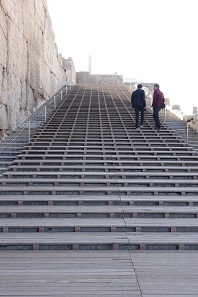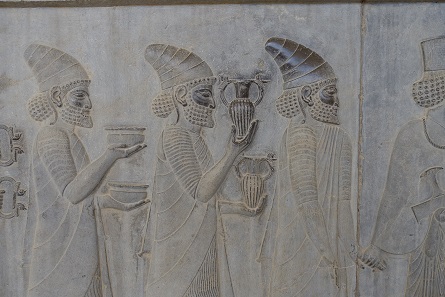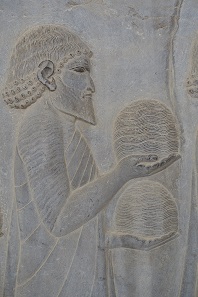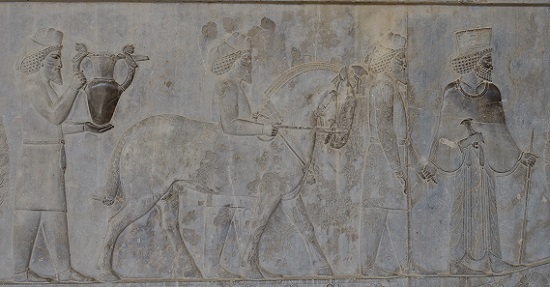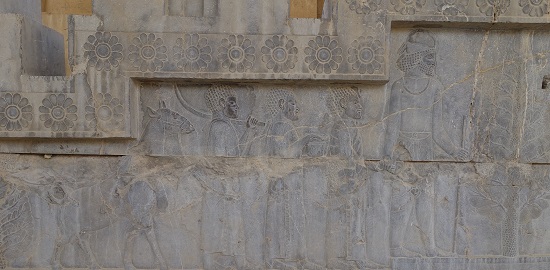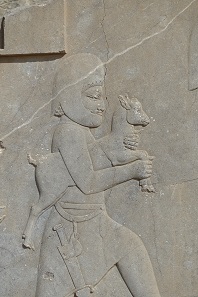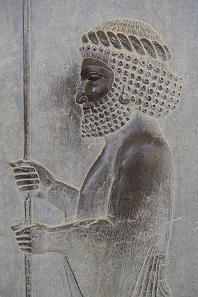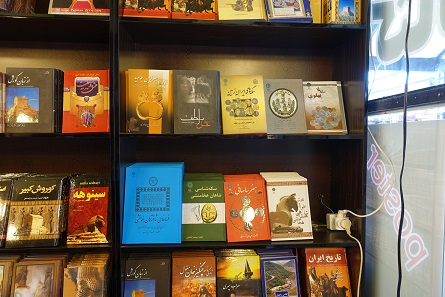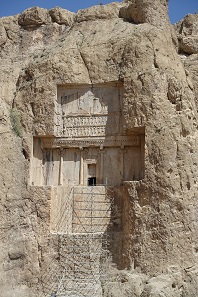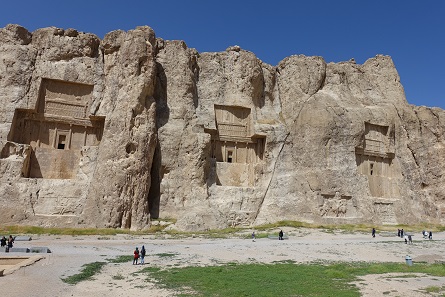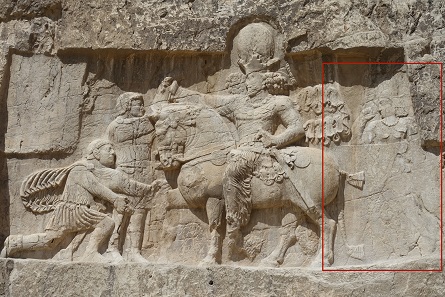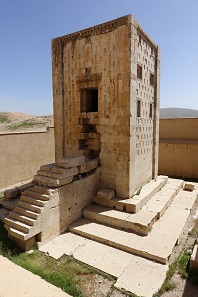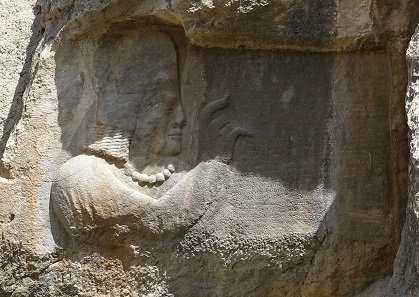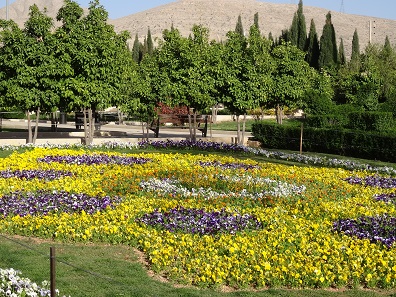by Ursula Kampmann
translated by Teresa Teklic
January 26, 2017 – I can imagine that every globetrotter has his little mental list, a bucket list with all the highlights he still wants to see in his life. At least I have such a list. Not physically, but in my mind. And for many, many years, the city at the very top of this list has been Persepolis!
The modern staircase in Persepolis. Photo: KW.
Wednesday, 16 March 2016
Today was the day of all days! Today we saw Persepolis! Granted, we had to get up early as usual, 6.00 am to be precise. Departure was at 7.30 and shortly after 9.00 we arrived in Persepolis. Before everyone else!!! Our bus looked all forlorn in the huge parking lot. Usually, we were told, things around here were not that well-regulated and organised but the New Year’s celebration would take place in a few days and on that occasion the administration of Persepolis was expecting some 2 million visitors. Not foreign visitors though. Locals! Unlike many other nations around the world the Iranians are enthusiastic visitors of their own excavations and the first 10,000 arrivals were already expected for today…
The Gate of all Nations – once the entrance to the Palace of Darius. Photo: KW.
Well, we were the first 23 of the 10,000 and shortly after 9.00 we were ascending the spacious, modern staircase. Using the staircase is a necessity since the entire palace of Persepolis is elevated on a huge, artificial platform: 300 m in breadth, 455 m in length, and an incredible 15 m in height. The Gate of all Nations, with its four bulls securing it in all directions, was impressive enough. Less uplifting was the fact that the visitors of Persepolis have been immortalising themselves by scratching their names in the rock for a good 200 years. Their graffiti are now behind glass, equally protected as the original reliefs.
And then we couldn’t wait another second. Nothing could make us stay with the group – even though we would have probably learned more had we stayed and listened to Ms Hodel’s detailed explanations. But we were in Persepolis!!! And over there was the Great Apadana!!! And we had to see it right now, no, sooner than that!
The famous Apadana. Photo: KW.
What can I say? It was a unique experience. Of course the photographs in the many coffee-table books published about Persepolis are first-rate. Everybody knows what the delegates offering their gifts to the king on New Year’s day look like. But standing in front of the originals – that is something else entirely.
The Lydian delegates offer their gifts. Photo: KW.
Persepolis was founded around 520 BC – under an entirely different name, Parseh, although it actually means just the same as the Greek name Persepolis: City of the Persians.
Darius I, 522-486. Daric, c. 500-485. From Gorny & Mosch auction sale 219 (2014), 292.
It was founded by Darius I, yes, no other than the Darius who reconquered the Persian Empire and expanded it all the way to India. It was under his reign that the Ionians rose up and were forced back into his empire. It was Darius who lost the Battle of Marathon, which a handful of old-fashioned history teachers still believe to be an outcome of world-historical significance. As if the Athenians had been more tolerant rulers than the Persians!
Ionian offering a ball of especially fine-spun wool. Photo: KW.
Persepolis was a sort of capital for the Persians, although the purpose it served was far from what we would normally expect from a capital. The Persian Empire was administrated from more centrally located places like Susa, Babylon, or Ecbatana. Persepolis was the spiritual capital, the place where the burial sites of the ancestors were. The place where the Persian rulers probably celebrated Newroz, the first day of the new year, on which representatives of all subject peoples brought gifts.
Armenian delegate presenting a skilfully made vessel and a horse with an intricate bridle. Photo: KW.
That the entire site was carefully built in accordance with the celestial bodies seems plausible in this context. On the day of Newroz, the vernal equinox – according to our calculations on March 21 – the morning sunlight comes in through the Gate of all Nations.
The Ethiopians bring ivory as a gift. Photo: KW.
In this context, the delegations’ offerings would qualify more as a tribute than as gifts. Although there is a fine line between gift and tribute, as we all know…
The Apadana which was used for the audiences, further back another palace of Darius. Photo: KW.
Despite my extensive reading up on the Apadana, I had somehow managed to overlook the fact that there are many other impressive buildings in Persepolis. We crossed the palace of Darius used for the audiences and noticed on the way that the Great Apadana is apparently called Great Apadana because there are other, smaller Apadanas.
Carrier with gift on the staircase leading to the Palace of Darius. Photo: KW.
Messengers and carriers bearing gifts decorate more than one staircase…
The Persian king in the shade of his ceremonial parasol. Photo: KW.
… and the king under his ceremonial parasol is peering around every second corner (or column, in this case).
A look into the enormous 100 column hall. Photo: KW.
We enjoyed the calm before the storm – meaning before 10.30 when the crowds started to arrive in Persepolis. Most of the visitors, however, were not hysterical tourists but mainly locals on family outings. We also saw a group of Kurdish men in their picturesque Sunday attires with broad sashs around the belly. The Iranians are proud of their pre-Islamic past and visiting its illustrated testimonies may well have been a political statement against Wahhabi radicalism. Just like elsewhere, we were welcomed in Persepolis by the locals, though always separated by gender: Kurt by the men, I by the women.
View of Persepolis from the tomb of Artaxerxes II. Photo: KW.
We even climbed up to the tomb of Artaxerxes II. I don’t even want to imagine what the TÜV (the German Technical Inspection Association) would say about the safety precautions along the path (or rather the climbing route). It sure wasn’t hard to find a spot from which one could have easily suffered a pretty bad fall. Yet, what an incredibly view one had from the top. Persepolis was literally at our feet!
Spear-carrier in the Great Apadana. Photo: KW.
I have to admit that there were tears in my eyes at some point. Persepolis is one of the few places on this planet that I wanted to see at least once in my life. And now I’d seen it. Now it was over. And no one would be able to take this memory from me, not ever!
The souvenir shops offer a lot of numismatic literature. It would be nice if it were like this everywhere in the world. Photo: KW.
Unlike the many other sites that we had seen in the last few days, Persepolis’ touristic infrastructure was pretty solid. You could buy refreshments and even grab a quick bite. Yes, they even had a real café, where one could have sat down to recall all the things seen. We discovered postcards and even stamps (!) – by the way, for the very first time on our trip. We actually found an excellently stocked book shop, which not only offered a first-class travel guide of Persepolis in German, but also a number of numismatic books – unfortunately all in Farsi. But still, this is solid proof that not only tourists buy books in Persepolis. And of course you had your usual souvenir shops with souvenirs of highly questionable artistic value. It would have been the perfect time for some window shopping. But we had already exhausted our time limit, including the time it had taken us to buy the German travel guide, and were about to get on the bus again since we had yet to cover another important point on our morning agenda: the tombs of Naqsh-e Rustam.
Tomb of Xerxes I. Photo: KW.
We had already seen the Achaemenid tombs from the far distance but only once we stood right in front of them did we realize how impressive they were. Darius I was the first to be buried here. The façade of his tomb is shaped like a cross, the entrance to the burial chamber in the centre, carved into the rock. The lower half of the cross is unadorned. Perhaps the reason was a religious one, or perhaps the empty surface served a pragmatic purpose, namely to hold the scaffold needed to work on the upper parts.
Tomb of Darius I. Photo: KW.
What follows is a sort of architectural trompe l’oeil, …
Detail from the tomb of Xerxes. Clearly recognizable: Columns ending in bull protomes and the representatives of the royal subjects supporting his deathbed. Photo: KW.
… on which the Persian columns support a ceiling, on which the king kneels before Ahuramazda and a fire altar, praying. The deathbed with the praying king is carried by representatives of the Empire’s various peoples.
Tombs of Naqsh-e Rustam. Photo: KW.
Modelled on the tomb of Darius are further tombs, for instance that of Darius II, that of Artaxerxes I, and the best-preserved one, which is attributed to Xerxes I.
Jousting Vahram II. Photo: KW.
And as if that hadn’t been enough attractions for one day, there were eight Sassanid rock reliefs all in all, visitor-friendly installed at eye-level. Once more Philip the Arab throws himself on the ground before Shapur I to beg him for peace. Another stunning relief is the investiture of Ardashir. But what impressed me the most was all the equestrian reliefs which show Sassanid rulers on horseback. It feels as if you travel back in time, to the Middle Ages and the tournament era, where horsemen were trying to unhorse their fast-approaching opponents.
Shapur with the three Roman emperors; behind him the priest Kartir. Photo: KW.
At least equally fascinating is the figure of the priest Kartir. He occasionally appears on the reliefs of Sassanid rulers. And Ms Hodel cannot stand Mr Kartir for the life of her. He was a reformer of the Zoroastrian faith and, as reformers tend to be, Monsieur Kartir didn’t believe in tolerance. It was him, apparently, who called to the persecution of Jews, Buddhists, Hindus, Christian, and Manicheans in the Sassanid Empire. It is said that he even had the prophet Mani assassinated. The transformation of the holy local shrines into fire altars is on him. And of course good old Kartir was mighty proud of his religious fanaticism as he tells us in numerous inscriptions. The fact that he was granted the privilege to be depicted on royal reliefs alone, to be seen by all posterity, speaks volumes.
The so-called House of Zarathustra. Photo: KW.
Apparently that still wasn’t enough with the attractions, so just opposite the tombs there is the House of Zarathustra. Not that he ever lived there but it is nevertheless a Sassanid building towering over the desert and excellently preserved. It once displayed an inscription by Shapur I, a kind of account of his political and religious doings. A Sassanid Monumentum Ancyranum!!!!! And I didn’t even know such a thing existed. One thing that struck me as telling about the prevailing attitude at the Sassanid court after the death of Shapur, though, was that the priest Kartir authored an inscription there, which, believe it or not, comments on that of the king!
Persepolis’ biggest attraction: This restaurant actually had western flush toilets, which we’d only seen in the hotels we’d been staying in so far. Photo: KW.
Now we were more than ready for lunch. And since there simply is no other hotel, all larger groups lunch in the same hotel. The owner of the hotel, Ms Hodel tells us, started from scratch. Ever since, the complex of buildings has expanded every year. Add a hall here, some trick fountains there. For people with an entrepreneurial spirit this country offers so many opportunities! The only question is in how far a slow and in some parts of the country possibly corrupt administration allows for such initiatives.
The rock reliefs of Naqsh-e Rajab. Photo: KW.
More Sassanid rock reliefs in the afternoon. And someone joked that he wanted to see the one and only, the really big attraction in Persepolis: a rock face with no Sassanid relief on it.
Two enigmatic figures. Photo: KW.
To the left and right Naqsh-e Rajab once more shows the transfer of power as we have seen it repeatedly. But in the centre there is a very curious depiction of the transfer of power to Ardashir I. Especially the interpretation of the two figures turning away from Ardashir remains contested. Is this the spouse of the king? A priest with long hair? More than anything I wonder what it means that two people are turning away from the ruler in a scene as important as the transfer of power.
The priest Kartir showing off. Photo: KW.
By the way, the priest Kartir once again appears in the background here, with a portrait and an inscription glorifying his deeds… Sometimes it is truly unfortunate that we don’t have more written records of Sassanid history. It would probably be just as lurid as the reports by Tacitus and Suetonius.
Flowers in front of the Tomb of Saadi in Shiraz. Photo: KW.
Then we were done with the Achaemenids and the Sassanids for the day. Still on the to-do list was the city of Shiraz, or rather things to see in Shiraz. First we drove to the pretty Eram Garden. Well, the little Qajar castle with its tiles was quite picturesque. And burst water hoses will do just fine as trick fountains. But we had seen Persepolis. Somehow the garden was just so normal. At least we discovered a small café which promised to serve espresso. Well, turns out this was a pretty misleading descriptor for the beverage that we really got, but at least they know how to spell it right in Persia. It can’t be long until they learn how to make it right, too…
Same thing with the modern Tomb of Saadi. Don’t get me wrong. I like Saadi. But the tomb by Godard is from the 50s of the last century. And we had been in Persepolis! The prettiest pink roses, the most delightful little birdies on the tiles, they all had nothing on Persepolis.
And so we made our decision. We let the bus drive to the Tomb of Hafez without us. Not that I don’t appreciate the poet – although I cannot bring myself to pay him the same respect as our poet laureate Goethe did, his verses are just too complicated for that… But our eyes were so filled up with what we had seen. Our faces sunburnt. It was hot. And there were taxis which could drive us back to our hotel. And so we arrive at the hotel at 4.30 pm, still attempt to believe the unbelievable, that we’d been in Persepolis!
The next episode of our travelogue leads us to Pasergadae to the tomb of Cyrus the Great. And see the fire temple of Yazd.
You can find all episodes of my Iranian travelogue here.



